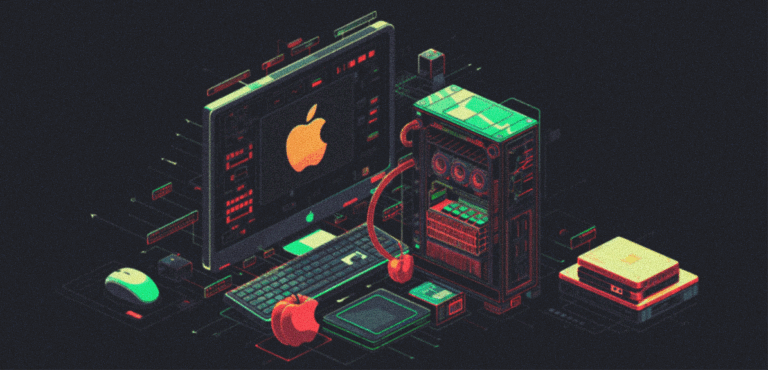
Apple Goes All-in with DarwinAI Acquisition
Apple’s recent acquisition of DarwinAI hints at a far more strategic deep dive production, delivery, and manufacturing of perfect phones. DarwinAI, a Canadian powerhouse, carved a niche for themselves in the cutting-edge fields of machine vision and intelligent manufacturing – two areas that perfectly align with Apple’s ambitions to create superhuman technology.
Imagine AI systems on the iPhone production line that meticulously inspects every single component, identifying even the most minute defects with superhuman precision. This isn’t science fiction – it’s the future DarwinAI’s technology could usher in for Apple. Their expertise lies in machine vision, the ability for computers to interpret and analyse visual data. DarwinAI’s solutions can analyse images and videos with remarkable accuracy, revolutionising Apple’s manufacturing process.
Machine vision is just the tip of the iceberg. DarwinAI also boasts expertise in intelligent manufacturing, a field that utilises AI to optimise production processes that could have a profound impact on Apple’s facilities.
Apple goes diving toward supercharged manufacturing
DarwinAI’s technology has the potential to revolutionize Apple’s manufacturing process in several key areas: predictive maintenance, resource allocation, and quality control.
By analysing sensor data from machines, AI could proactively identify potential failures before they occur. This would minimize downtime and ensure a smooth production flow, saving Apple both time and money. AI could become the mastermind behind resource allocation. Analysing production data in real-time, it could dynamically adjust labour and materials for maximum efficiency. This could lead to significant cost savings and increased production capacity.
DarwinAI’s technology, equipped with machine vision and AI algorithms, could elevate quality control to unprecedented heights. Every single Apple product could undergo a rigorous AI-powered inspection, guaranteeing consistent adherence to the highest quality standards.
A smarter Apple ecosystem
The impact of DarwinAI’s technology could extend far beyond the factory floor. Here’s a glimpse into how specific Apple products might evolve with the help of AI:
iPhones and iPads
Imagine an iPhone camera that intelligently adjusts settings based on the scene you’re capturing, or an iPad that recognizes objects in real-time, enabling more interactive augmented reality experiences. Developers could harness machine vision to create even more intuitive camera features.
Apple watch
The Apple Watch could personalize the user experience to an unprecedented level. For instance, an Apple Watch could tailor its health recommendations based on your individual physiology, sleep patterns, and activity levels. It could even proactively suggest workouts or healthy meal options based on your personal goals and progress.
Macs
Envision, for instance, a Mac that learns your most frequently used applications and, as a result, automatically opens them when you log in. Additionally, it could suggest relevant files and folders based on the current task. In this way, AI could anticipate your workflow needs on a Mac and automatically adjust settings accordingly. Ultimately, this would significantly improve user productivity and streamline the overall experience.
Subscribe to our bi-weekly newsletter
Get the latest trends, insights, and strategies delivered straight to your inbox.
Apple Vision Pro
Apple’s innovative mixed-reality headset could leverage DarwinAI’s expertise in several ways. Consider an Apple Vision Pro that can seamlessly translate real-world objects and text into digital information, or one that personalizes the virtual environment based on your gaze and attention.
Privacy concerns and the responsible use of AI
As Apple integrates AI deeper into its products, privacy concerns will undoubtedly arise. Apple has always emphasised user privacy, and it will be interesting to see how they navigate this challenge. Organizations must ensure they implement AI features ethically and responsibly, protecting user data and using it transparently. Here are some key considerations:
- Data security: Robust safeguards will be needed to ensure user data collected by AI features is secure from breaches or unauthorised access. Apple’s strong track record in data security is reassuring, but with increased data collection comes increased responsibility.
- Transparency and user control: Users should have a clear understanding of how their data is being used by AI features and the ability to opt out of data collection or specific uses of their data. Transparency is crucial for building trust with users.
- Bias in AI algorithms: AI algorithms can perpetuate biases present in the data they are trained on. Apple will need to ensure their AI systems are developed and implemented in a way that minimises bias and promotes fairness.
The competitive landscape: how does Apple stack up?
Apple isn’t the only tech giant vying for dominance in the AI space. Google is a leader in AI research and development, with products like Google Assistant and DeepMind showcasing their capabilities. Apple will need to find innovative ways to differentiate itself in this crowded market. Perhaps by leveraging its focus on user privacy and tight integration between hardware and software.
Microsoft’s Azure cloud platform offers a robust suite of AI tools, and they’ve made significant progress in areas like natural language processing. Apple could leverage its design expertise to create a more user-friendly and intuitive AI experience.
Distilled
Apple;s acquisition of DarwinAI serves as a strong indicator of Apple’s commitment to AI and its vision for the future. With the potential of DarwinAI at its disposal, Apple is poised to take a significant bite out of the AI apple, and the future looks intelligent indeed.